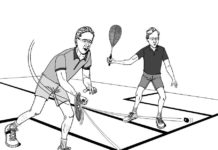
By Barry Faguy
HEY REF! It really gets on my nerves when I have an opponent who takes too long between rallies, either to serve, or to receive serve—especially if they obviously need to catch their breath. I’ve only been told by players that, unlike for tennis, squash does not specify the allowable time to get the ball into play. What can I do?
It’s true that squash doesn’t have a specified limit for time between rallies, but some key provisions make clear the need to not have delays:
- “Play must be continuous as far as is practical”
- “After the marker has called the score, both players must resume play without unnecessary delay.”
The referee is authorized to apply the Conduct Rule (warning, stroke, etc) to a player who delays play unnecessarily. The definition of delay will vary with each referee—but typically, a 5 to 10 second interval is the norm, depending of course, on circumstances. The opponent’s reaction (such as yours) to any delay can sometimes be used as a clue that maybe the reasonableness is being tested. As added emphasis, the rules advise that the marker “must call the score without delay at the end of a rally.” Finally, if you don’t have a ref, you might try to appeal to your opponent’s sense of fairness about following the rules.
HEY REF! Whose fault is it when the server continually hits a very wide serve which appears to force the receiver to continuously turn on the ball—which usually results in a let for fear of injury? Does the server need to change the serve, or does the receiver need to change the return (meaning, not turning—by instead backing away from the ball)?
Yet another chicken-or-egg problem that has been debated to death, because repeated occurrences have often led to friction between the players. Here are two possible resolutions: firstly, the players should have a civil chat and figure it out between themselves; failing that, the referee may possibly intervene with what is colloquially referred to as the ‘unnecessary turning’ provision—but applied fairly. This provision denies a let to the receiver who has “turned in order to create an opportunity to request a let.” This means that it must be obvious to the referee that stopping play is the primary reason the player turned. Re-read that last statement!
So, this is not about choosing to turn instead of choosing to play the shot without turning. The rules never dictate a player’s options. This is about punishing poor behavioral intent that wants to avoid continuous play. So how do you tell the difference? A hallmark of such poor intent is when you see that the turning action is obviously automatic, without the receiver actually following the ball with the intent to play it, and that, in combination with the server being well clear (so, no fear of injury). The lion’s share of turning actions are entirely legitimate, and care must be taken to avoid unfairly limiting a player’s options to return the ball by use of the No Let. Remember: “Officiating is not rocket science—it’s much harder!”
HEY REF! Does the striker have the right to delay hitting the ball—or must it be hit at the first opportunity?
This is often a very irritating scenario for many players, because such delaying actions are often viewed as attempts to unfairly fish for strokes. Nonetheless, there is no specific provision that addresses delays in hitting the ball. Therefore, such delays are allowed, and the obligation of the non-striker to make every effort to clear remains. Of course, this applies so long as the ball remains playable (e.g., before the ball has bounced twice)—a detail that is often overlooked if you, as referee, are concentrating solely on any swing interference during any such delay, and forget to notice the location of the ball.
However, the same does not apply to interference that occurs during a further attempt. In those cases, a provision gives the non-striker a break, even if, for example, the interference to the swing was major (“prevented”). So, if you determine that the non-striker “had no time to avoid the interference,” the typical award of a stroke would now instead be a let.





